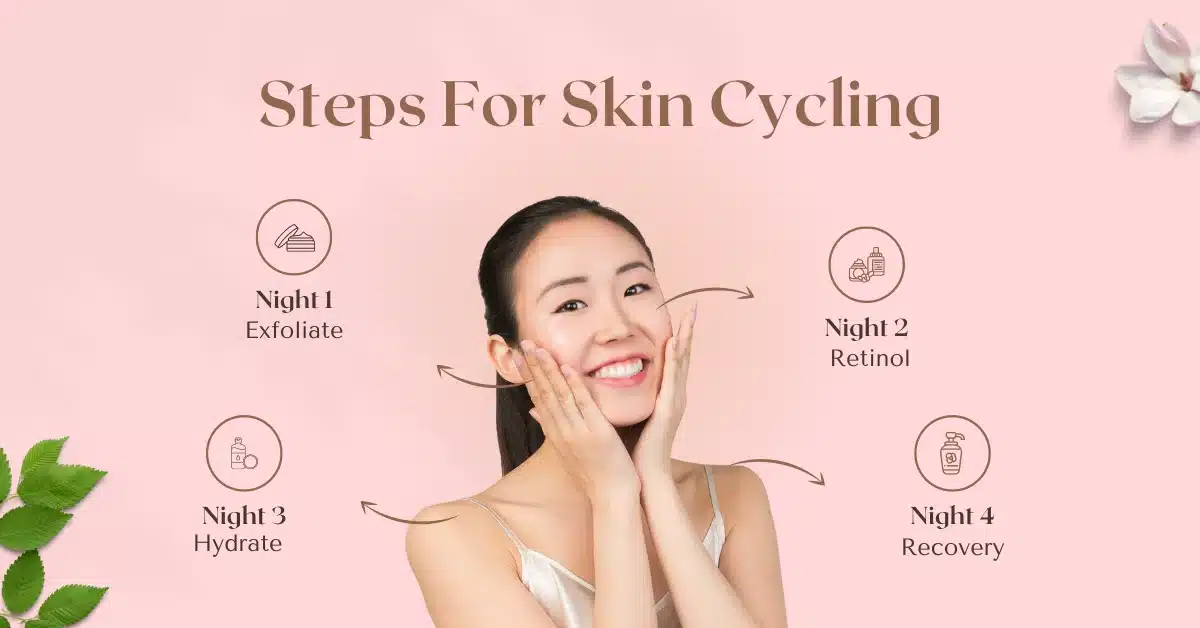Mastering Skin Cycling: Your Ultimate Roadmap

Hey there, fellow skincare enthusiast! Ever felt like your skin has its own set of moods? Some days, it’s as radiant as a summer morning, and on others, it’s more reminiscent of a moody winter sky. Enter the concept of skin cycling, a proactive approach to skincare that understands these shifts and provides what your skin craves at different times.
Let’s dive deep into this transformative skincare routine that could just be the game-changer you’ve been waiting for.
Table Of Contents
- What Is Skin Cycling?
- Understanding The Basics Of Skin Cycling
- Why Skin Cycling Matters
- Benefits Of Incorporating A Skin Cycling Routine
- Skin Cycling Nighttime Routine
- How To Kickstart Your Skin Cycling Routine
What Is Skin Cycling?
Skin cycling is an evolving concept in skincare that revolves around adjusting one’s skincare routine in response to the skin’s changing needs. Instead of sticking to a strict regimen year-round, skin cycling promotes the idea of switching products or treatments based on various factors that may influence the skin’s condition.
Understanding The Basics Of Skin Cycling
Skin cycling revolves around the idea that your skin’s needs change daily and monthly. Here’s a breakdown of the two primary cycles involved:
#1 Daily Skin Cycle
Morning: Your skin may be slightly oilier in the morning as it produces sebum during the night. Cleansing and moisturizing in the morning can help maintain a fresh complexion.
Evening: In the evening, your skin may become drier. Nighttime is when your skin focuses on repair and regeneration. This is an ideal time for applying targeted treatments and richer moisturizers.
#2 Monthly Skin Cycle
Throughout the Month: Hormonal fluctuations, influenced by your menstrual cycle, can affect your skin’s condition. You may notice changes in oiliness, breakouts, or sensitivity at different points during the month. Tailoring your skincare to these changes can help manage these variations effectively.
Why Skin Cycling Matters
Skin cycling matters for several reasons:
1. Optimized Skincare
By aligning your skincare routine with your skin’s natural cycles, you can maximize the effectiveness of your products. This means addressing specific concerns when your skin needs them the most, such as focusing on hydration during dry periods or acne management during breakouts.
2. Prevent Overloading
Adhering to a consistent skincare routine may not always be ideal, as your skin’s needs vary. Skin cycling prevents the overuse of products and potential irritation by ensuring you apply the right products at the right times.
3. Personalized Approach
Skin cycling encourages a personalized approach to skincare. It recognizes that what works for one person may not work for another and allows you to adapt your routine to your unique skin type and concerns.
4. Efficient Use of Resources
Skin cycling can help you use your skincare products and resources more efficiently. Rather than using every product every day, you can use them strategically, extending the life of your products.
5. Improved Skin Health
By providing your skin with what it needs when it needs it, skin cycling can lead to healthier, clearer, and more radiant skin. It can address specific issues more effectively and promote a balanced complexion.
Benefits Of Incorporating A Skin Cycling Routine
Incorporating a skin cycling routine can offer numerous advantages, as it’s an approach tailored to the skin’s fluctuating needs. Here are some of the key benefits:
- Adaptability: Skin cycling allows you to adjust your skincare routine based on changing needs, ensuring that your skin receives the most appropriate care at any given time. This flexibility can be particularly beneficial during seasonal transitions, hormonal fluctuations, or lifestyle changes.
- Improved Skin Health: By using products that align with your skin’s current state, you are more likely to support its natural processes, improving overall skin health and appearance.
- Reduced Risk of Irritation: Overusing certain products or combining incompatible ingredients can irritate the skin. Skin cycling encourages a more measured approach, reducing the risk of over-sensitization or adverse reactions.
- Enhanced Product Efficacy: When you use products tailored to your skin’s immediate requirements, you will likely see better, more rapid results. For instance, using acne-fighting ingredients during breakout-prone periods will address the issue more effectively than a generic moisturizer.
- Prevention Over Cure: By understanding and anticipating the skin’s needs, skin cycling often takes a preventative stance. This proactive approach can reduce the severity of potential skin issues or even prevent them from occurring.
- Customization: Skin cycling promotes a personalized skincare routine, ensuring that products and treatments align with individual skin types, concerns, and goals.
- Economic Efficiency: Using products as and when needed can extend their lifespan, making your skincare investment more cost-effective in the long run. You’re less likely to waste products by using them when they’re not beneficial.
- Mindfulness and Connection: Adopting a skin cycling routine encourages a deeper connection to one’s skin. This mindful approach can make the skincare routine more of a nurturing ritual than a chore.
- Versatility: Skin cycling allows you to explore various products and understand which combinations work best for different situations, making your skincare routine versatile and dynamic.
In essence, the benefits of skin cycling are rooted in its adaptive and responsive nature. By being attuned to the skin’s changing needs and addressing them proactively, this approach can lead to healthier, more radiant skin.
Skin Cycling Nighttime Routine
Night 1: Exfoliation
The first night of your skincare routine is dedicated to exfoliation. Choose either a physical exfoliant or a chemical exfoliant based on AHAs or BHAs, selecting the one that best suits your skin type and current skin condition.
Chemical exfoliants, containing AHAs or BHAs, work by gently accelerating the cell renewal process. In simpler terms, they help speed up the process of replacing aging skin cells with fresh ones.
On the other hand, physical exfoliants contain tiny particles that, when massaged gently into the skin, assist in removing dead skin cells and impurities. However, please note that this form of exfoliation can be somewhat abrasive and is generally recommended for non-sensitive skin types.
Night 2: Retinol
Retinol is a powerhouse when it comes to combating the signs of aging, such as age spots, wrinkles, expression lines, loss of firmness, and dullness.
On the second night of your routine, after removing makeup and cleansing your face, apply a small amount of retinol cream and leave it on your skin overnight.
It’s crucial to select the right retinol product for your skin. Begin with a milder retinol concentration to let your skin adjust gradually. The process of skin adaptation to retinoids, known as “retinization,” can take up to three months.
If you experience some sensitivity initially, there’s no need to worry. We recommend using nourishing and soothing products to mitigate any adverse effects. However, if your skin becomes overly irritated or you feel a burning sensation, it’s advisable to consult with a skincare specialist.
Additionally, always apply sunscreen during the day to protect your skin.
Nights 3 and 4: Skin Rejuvenation
On nights three and four, it’s time to give your skin a break and focus on intense rejuvenation.
If you have dry skin, opt for a deeply nourishing hydrating cream for a rich dose of moisture.
For those with oily skin, consider limiting hydration to just one night and using a lighter cream or a concentrated product.
If you have sensitive skin, it’s advisable to use soothing products.
These two nights are essential for providing your skin with the necessary hydration and renewal tailored to your skin type and needs.
How To Kickstart Your Skin Cycling Routine
Starting your skin cycling journey might seem daunting, but with some thoughtful observation and a few adjustments, it can become an intuitive and beneficial process.
Here’s a step-by-step guide to help you kickstart this approach:
1. Understand Your Skin Type
Before diving into skin cycling, it’s crucial to know your baseline. Understand whether your skin is oily, dry, combination, sensitive, or normal. It gives you a foundation upon which to make adjustments.
2. Observe and Journal
For a few weeks, maintain a skincare diary. Note down how your skin feels and looks every day. Track factors like climate, menstrual cycle, stress, and diet, as these can all influence skin health. Over time, patterns will emerge, helping you anticipate and address changes.
3. Start Slowly
Don’t overhaul your entire routine at once. Start by switching out one product at a time based on the needs you’ve identified. For instance, if your skin gets drier in cooler months, introduce a more hydrating moisturizer.
4. Curate a Versatile Skincare Wardrobe
Have a selection of products that cater to different skin needs. This doesn’t mean buying everything all at once but gradually building a collection that allows you to respond to changes. It could include various moisturizers, serums, and cleansers.
5. Stay Informed
Research ingredients and understand their benefits. For example, hyaluronic acid is great for hydration, while salicylic acid can be beneficial during breakout-prone phases.
6. Prioritize Sun Protection
No matter how you adjust your routine, never skip sunscreen. UV protection is essential year-round.
7. Listen to Your Skin
If something feels off or a product causes irritation, don’t hesitate to revert back or try something new. Skin cycling is about intuition and adaptability.
8. Consistency is Key
Even when cycling, it’s essential to maintain a consistent skincare routine. It means cleansing, treating, moisturizing, and protecting your skin daily.
9. Seek Professional Advice
If you’re unsure about adjusting your routine or dealing with specific skin concerns, consulting with a dermatologist or skincare professional can provide valuable insights.
10. Review and Adjust
Every few months, review your skincare diary and the products you’ve been using. This helps you understand what’s working and where further adjustments might be beneficial.
Remember, skin cycling is about recognizing that our skin is a dynamic organ influenced by various factors. By adopting a flexible approach and being attuned to these changes, you can ensure your skin receives the best care possible, leading to a healthier, more radiant complexion.
And there you have it, a comprehensive look at skin cycling. It’s fascinating, isn’t it? Think of it as tuning into your skin’s unique song, adjusting the rhythm and beats as it changes. By embracing this dynamic approach, you’re not just applying products but actively nurturing and conversing with your skin. So, the next time your skin decides to switch up its mood with skin cycling, you’ll be ready to dance along! Cheers to a harmonious skin journey ahead.
FAQs
Q: What is skin cycling?
A: Skin cycling is a skincare approach where one adjusts their routine based on the skin’s changing needs, influenced by factors like climate, hormones, and stress.
Q: How does skin cycling benefit the skin?
A: Skin cycling caters to the skin’s dynamic nature, addressing its specific needs at any given time, leading to better hydration, reduced breakouts, and overall improved skin health.
Q: Can skin cycling lead to skin irritation?
A: If done correctly, skin cycling should not cause irritation. It’s about gentle transitions based on skin needs. However, always patch-test new products to ensure they’re compatible.
Q: Is skin cycling suitable for sensitive skin?
A: Yes, skin cycling can be tailored for all skin types, including sensitive. It’s about recognizing and responding to your skin’s needs, which can be especially beneficial for sensitive skin.
Q: Can I combine skin cycling with other skincare methods like double cleansing or the 10-step routine?
A: Absolutely! Skin cycling is flexible and can be integrated into any comprehensive skincare routine. It’s all about product choice and timing.
Q: How do I know which products to use at different times in skin cycling?
A: Observation is key. Note changes in your skin, and adjust products based on dryness, oiliness, breakouts, or other factors. Over time, patterns will emerge, guiding your choices.
Q: Is skin cycling a fad or backed by science?
A: While the term “skin cycling” might be trendy, the concept is grounded in addressing the skin’s dynamic nature, which is a well-accepted principle in dermatology.
Q: What if skin cycling doesn’t work for me?
A: Everyone’s skin is unique. If skin cycling isn’t beneficial, consult a dermatologist or skincare professional for guidance tailored to your needs.
References
https://www.nytimes.com/2022/10/06/style/skin-cycling.html
https://www.everydayhealth.com/healthy-skin/what-is-skin-cycling-and-should-you-try-it/
https://www.mesoestetic.com/blog/skin-cycling-what-is/





